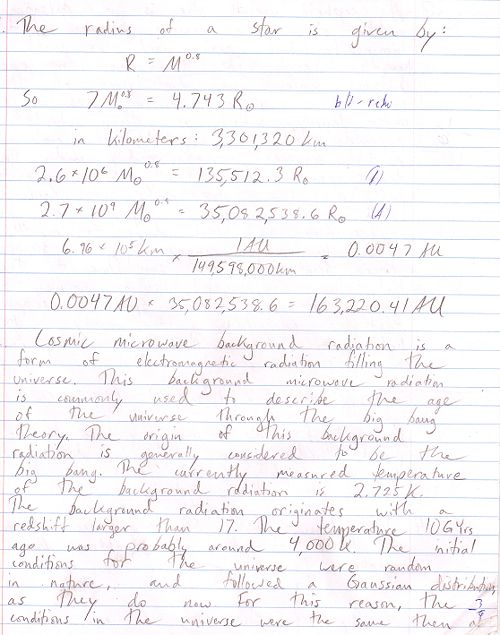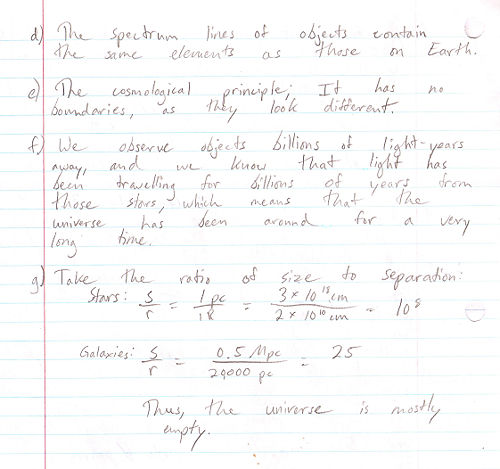Homeworks 11
Homework 11 due on 12/02/09 counts double
Problem 1
The black hole in the binary star GS 2000+25 has a mass of 7 M⊙. What is its radius in kilometers?
Schwarzchild Radius
1 M⊙ = 1.9891 × 1030 kg
G = 6.673 × 10-11 N m2 / kg2
c = 3.00 × 109 m/s
r = 20.303 km
The black hole at the center of the Milky Way has a mass of 2.6 × 106 M⊙. What is its radius in solar radii?
Schwarzchild Radius
1 R⊙ = 6.955 × 1030 kg
r = 11 R⊙
The black hole at the center of the giant elliptical galaxy M87 has a mass of 2.7 × 109 M⊙. What is its radius in Astronomical Units?
Schwarzchild Radius
1 AU = 1.496 × 1011 m
r = 53 AU
Problem 2
Describe the cosmic microwave background radiation. The peak of spectrum of the cosmic microwave background is at about 1.1 millimeters (= 1.1 × 107 °A). What is the origin of the radiation?
Cosmic microwave background radiation is electromagnetic waves "leftover" from the Big Bang with a spectral peak at about 1 mm (microwave). This spectrum is similar to a black body spectrum.
What is the temperature of the radiation?
This radiation is about 2.7 K.
Estimate the red-shift at which the CMB originates from.
The temperature is red-shifted with a scale "a(t)": T is proportional to a(t)-1
Red shift at 600 km/s
Redshift is caused by gravitational density perturbations.
What was the CMB temperature some 10GYrs ago? Do you expect conditions which are very different from those we encounter now ? Justify your answer.
The CMB temperature some 10GYrs ago was probably much hotter than today due to the higher density of the universe shortly after the Big Bang. This temperature was about T = 3000K, with a spectral peak at 10,000 A
Problem 3
What is a Cepheid variable star and why does it vary? What is the range of their pulsation periods and luminosities? How do we find Cepheid variable stars in other galaxies? What is the Period-Luminosity Relation for Cepheid variables? Describe how Cepheid variable stars can be used to measure the distances to nearby galaxies.
Problem 4
Suppose we observe a supernova in a distant galaxy called “AST01” and another supernova of exactly the same kind in a distant galaxy called “AST02.” The supernova in galaxy AST02 is 100 times fainter than the supernova in galaxy AST01. How much further away is galaxy AST02 than galaxy AST01?
100 times fainter corresponds to the distance being 10 times greater. AST02 is ten times further away than AST01
Problem 5
Use the Jean’s mass to estimate the upper limit of galaxies that are in virial equilibrium. Use the virial T of 6 × 105K and a particle density of the proto-galaxy of 5 × 10−2cm−3. Assume that the least massive galaxies could have been formed with gas near the H-ionization temperature (10000K), estimate the lower mass cut. Use the Jean’s length to estmate the radius of the largest galaxies, and compare it to the Milky Way.
Problem 6
Suppose you measure the spectrum of a galaxy. The strong line of hydrogen normally found at 6563 °A is observed to be at 7219°A because of the Doppler shift. Use the Doppler shift formula to find the radial velocity of the galaxy, and then use Hubble’s law to calculate the distance to the galaxy. Use H = 70 km/sec/Mpc.
Problem 7
Describe how giant elliptical galaxies form. Why are giant elliptical galaxies generally found near the centers of rich clusters of galaxies and why is there generally just one or two giant ellipticals in a cluster? Why do giant ellipticals generally have little interstellar gas and dust?
Giant elliptical galaxies form when two of more galaxies merge together. They are found near the center of the galactic clusters because this is where galactic merging occurs most frequently. But because galactic merging does not happen too often, most clusters are limited to only one or two giant ellipticals. There is little dust and gas in giant elliptical due mainly because they are comprised mostly of older low-mass stars.
Problem 8
Briefly describe the spectrum of a typical QSO. Are the spectral lines absorption lines or emission lines? What elements are present? What causes the great breadth of the lines?
Problem 9
Describe how observations of globular clusters give the age of the universe. What is the age given by globular clusters?
Problem 10
List at least one observation that supports each of the following statements about the universe:
- The law of gravity holds everywhere.
- The laws governing electricity and magnetism hold everywhere.
- The laws governing nuclear energy hold everywhere.
- The material we observe in the universe using electromagnetic radiation is the same everywhere.
- The universe is extremely large.
- The universe is extremely old.
- The universe is mostly empty.











